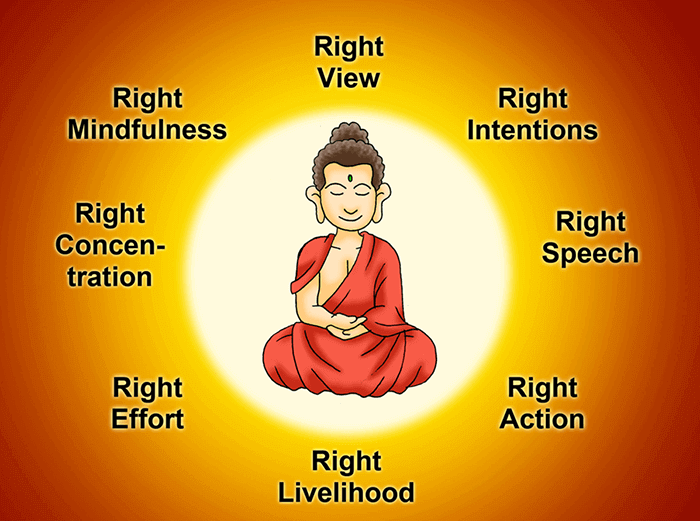Buddhism
by Devender
0 2536
Buddhism was founded by Gautam Buddha whose real name was Siddhartha. He was born in 563 BC at Lumbini in Nepal near Kapilavastu. Siddhartha was born as a Kshatriya in the Shakya clan and his parent's names were Suddhodhana & Mahamaya.
Buddhism
Siddhartha left his home at the age of 29 to find the truth and for that, he did immense penance & meditation. He attained nirvana under a Pipal tree at Bodh Gaya after which he has been known as Buddha which means the enlightened one. He delivered his first sermon at Sarnath (Banaras). He died at the age of 80 at Kushinagar (U.P).
- Noble truth by Buddha:
- The world is full of sorrow
- People suffer on account of desires
- If desires are conquered, Nirvana can be achieved i.e. free from the cycle of birth & death & which can be done by following 8 fold path (ashtangika marga):
- Tri Ratnas of Buddhism:
- Teachings by Buddha:
- Buddhist text:
- Sutta-pitaka
- Vinaya-pitaka
- Abhidhamma-pitaka
- Contribution of Buddhism:
- Cause of Decline of Buddhism:
- Brahmanism's revival and rise of Bhagavatism
- Use of Sanskrit instead of Pali after the 4th Buddhist council around the time period of 100 AD
- After the birth of Mahayana, the Practice of Idol worship, Huge offerings & donations became common & led to the deterioration of moral standards
- Attacks from Hunas and Turkish invaders destroyed major Buddhist monasteries
- Brahamana ruler Pushyamitra called for executing Buddhists
- Shaivite Shashanka asked to cut the original Bodhi tree at Bodhgaya
- First Council:
- Second Council:
- Third Council:
- Fourth Council:
- Origin of Mahayana Buddhism:
- Difference between Hinyana and Mahayana:
Right Understanding
Right Determination
Right Speech
Right Action
Right Exercise
Right livelihood
Right Mindfulness
Right Medication

1 Budhha (The enlightened)
2 Dhamma (Doctrine of Buddhism)
3 Sangha (Order of Buddhism)
Buddha did not believe in Soul, god, or the metaphysical world. He was a practical reformer and was concerned about worldly problems. He always suggested that a person should never have an excess of luxury and austerity. He prescribed a middle path. He always laid focus on Karma and Ahimsa while opposing the Verna system and laying down the principle of social equality.
Spread of Buddhism
It has two types of disciples Monks (Bhikshus) and others were Lay worshippers (Upasikas). For the purpose of spreading Buddhist teachings, Monks were divided into the sangha.
Membership of this society was open to all, anybody could join whether women or male from any caste but everyone had to take a vow of continence, poverty & faith. Buddhism used the Pali language which also contributed to its spread.
Tripitakas: All written in the Pali language.
Slaves and indebted individuals who couldn't join sangha rule helped moneylenders and more extravagant areas of society. The earliest Buddhist text "Suttanipata" argues for insurance of cattle and assisted with forestalling their obliteration and instructed individuals to place reason in all things and argued for rationale rather than odd notions thus advanced logic in individuals.
It provided advanced education through private colleges like Valabhi, Nalanda, and Vikramshila and also framed Hybrid Sanskrit by a combination of Pali and Sanskrit.
Buddhist Councils
This council was held at Rajgir immediately after the death of Buddha at Saptaparni cave in which the unwritten teachings of Buddha were written down following his demise. It was held under the chairmanship of Mahakashyap under the patronage of Ajatashatru of Rajgir.
In this council, Ananda composed Suttapitaka (Buddha's Teachings) whereas Upali composed Vinaypitaka (Monastic code for Buddhism).
It was held at Vaishali after 100 years of Buddha's death under the patronage of King Kalasoka under the chairmanship of Sabakami. It was held due to 10 points that were disputed under Vinaypitaka (Monastic codes of Buddhism).
It was held in Patliputra under the patronage of Ashoka under the chairmanship of Mogliputra tissa. In this council, the compilation of Abhidhamma pitaka took place. It is a Philosophical exposition of Buddhism. Buddhism which was preached and propagated by Ashoka is known as Hinyana.
The fourth council was held in Kashmir under the patronage of Kanishka under the chairmanship of Vasumitra. This council resulted in the division of Buddhism into two different parts: Hinyana & Mahayana. Asvaghosa was also a part of this council and everything was done in Sanskrit.
Around the beginning of the Christian era, Monks started to take huge cash and donations. They also started to accept non-vegetarian foreigners in Sangha. Even these Monks started eating non-veg food and lead a more luxurious life. They were accepting gold & silver and started wearing elaborate robes.
Disciples even let go of the religious order of Sangha & resumed their householder’s life. They also started using Sanskrit instead of Pali. They started worshipping idols of Buddha and started practicing rituals instead of his symbols.
This new kind of Buddhism was known as Mahayana (Greater Vehicle) & Hinyana (Lesser vehicle). Mahayana believed in image worship, rituals and Bodhisattvas whereas Hinyana continued to practice the old Buddhist ways.
1 Mahayana puts the individual at the center and was about the letter of Buddhist teachings whereas Hinyana centered Sangha and focused on the essence of Buddhist teachings.
2 Mahayana wrote scriptures in Sanskrit which are sutras, in Angas whereas Hinyana did it in Pali known as Pitakas.
3 Both believed in Karma but Hinyana believed in faith for salvation whereas Mahayana believed in work for salvation.
4 Mahayana only believed in the salvation of their own whereas Hinyana believed in the salvation of others.

Share:







Comments
Waiting for your comments